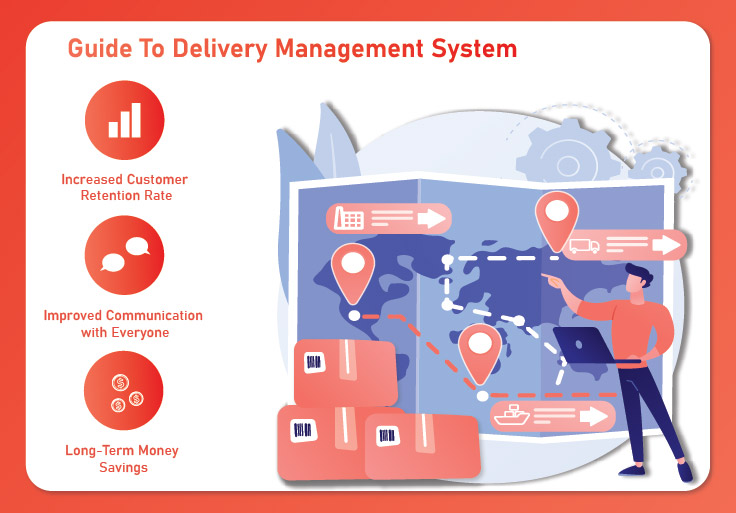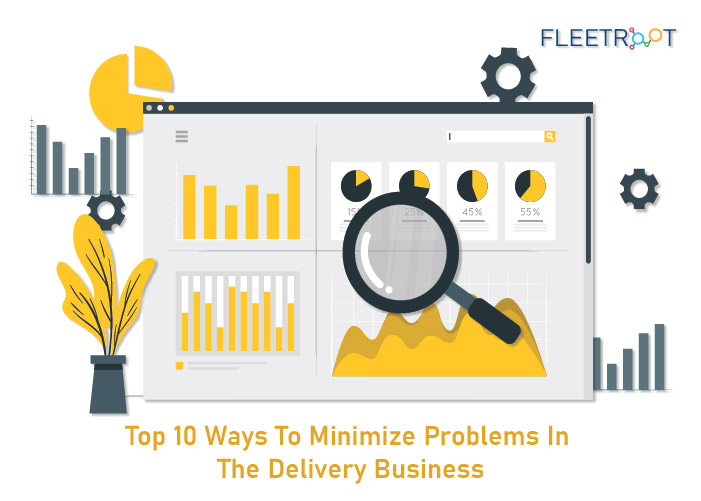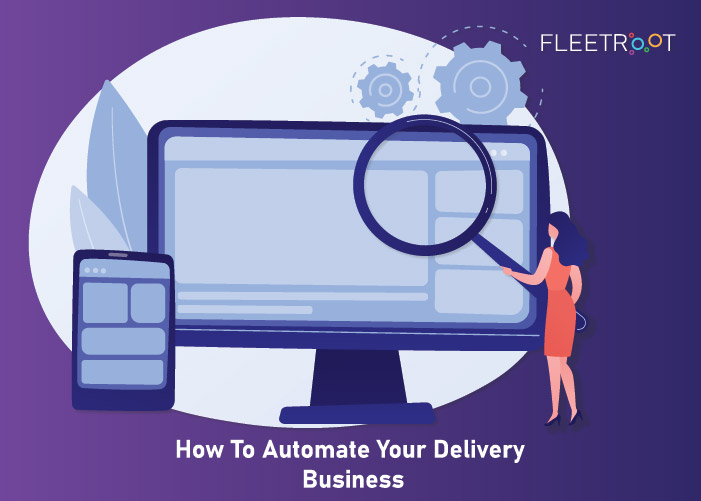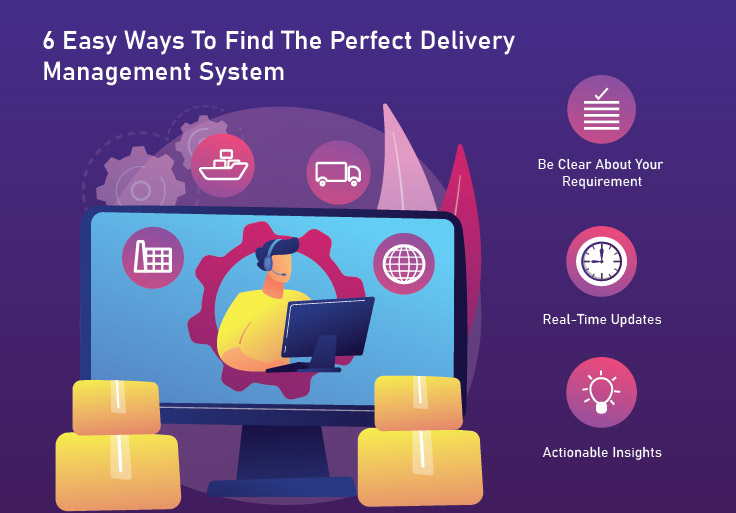To stand out in this highly competitive world, you need to run your business as efficiently as possible. Sooner or later, a company may be out of the race if they cannot operate efficiently.
It’s essential to do it in the right way when it comes to managing deliveries for customers. Mishandled shipments may negatively affect a company and its reputation.
Challenges During Goods Delivery
There are numerous reasons for careless deliveries.
Issues while finding the delivery addresses.
Customers are not aware of the estimated time.
Task scheduling becomes a time-consuming job.
Can’t keep track of drivers/agents.
Issues with the routes to follow
Finding it hard to communicate with delivery agents and drivers.
Lack of proper database of deliveries, customers, and agents.
What are the Solutions?
In order to manage your delivery system efficiently, you need software that can effectively improve your last-mile delivery.
The key to balancing your delivery techniques is its optimization.
Here’s what your delivery management system should be able to do.
Save the time of drivers and customers by finding addresses easily.
Automatically assign tasks to drivers in a streamlined way.
Able to track the driver’s location using GPS.
Utilize planning and scheduling tools.
Enable seamless communication between customers, drivers, and agents.
How does an ideal software help manage deliveries?
The delivery management software is a platform that integrates all the operational units and processes. Moreover, it simplifies the communication between the sender, the logistics company, and the receiver of the consignment.
An ideal system tracks goods from order creation to delivery. The system also provides proof of delivery to ensure that the goods are rightly delivered.
The difficulty in promptly accessing reports and status updates of the deliveries can delay decision-making capabilities. The integrated interface of the best delivery management system simplifies communication while saving turnaround time and easing the delivery process.
The human interference in delivery processes gives room for manipulations and misappropriations. It heightens the theft of goods. A complete delivery management software eliminates thefts that might occur during the delivery process.
The real-time tracking information and periodic alerts on events around the delivery eliminate human interference by enhancing visibility, traceability, and transparency of goods.
Benefits of a Delivery Management System
1. Information on Drivers in Real-time
One of the most advantageous perks of using a delivery management system is that it lets you track the information on your drivers in real-time once you fully integrate it.
Using it, you can access the location of drivers and customers with an advanced GPS. It helps you locate any potential issues in your delivery management that can be beneficial for your company.
2. Increased Customer Retention Rate
Covering customer retention is one of the most challenging aspects of a delivery management company. There are always competitors trying to lower their prices to sell their products.
However, money isn’t still important to increase your customer loyalty.
With a management system for delivery, you can implement necessary changes to increase the delivery time.
When you meet the delivery time faster, your customer’s satisfaction will also increase. It builds a loyal relationship between your brand and your customers.
3. Long-Term Money Savings
If there’s a saving of a few thousand bucks, why wouldn’t a business do that? Using a software system will decrease your need to hire employees to enter each detail manually. In this way, you can cut extra costs on exorbitant salaries.
Additionally, it’s an error-free system that will remove several issues created by humans. It’s also beneficial for your profitability backup.
4. Get Real-Time Updates on Incoming Deliveries
After getting your system fully integrated, you’ll also be able to get real-time updates on deliveries. Sometimes, deliveries can be late because someone didn’t get to the entry in time.
These systems automate out to a corresponding driver, giving it an almost hands-free approach.
5. Improved Communication with Everyone
Delivery management software does all the work with relative orders and fetching the information. Once you compile the information, it’s sent to your database to be distributed to your driver.
Your drivers won’t be confused about where they’re going. Besides, it allows you to check the processes as soon as delivery enters the system.
All the associated members get real-time information on their smartphones. So, in case of any changes or delays, the system keeps everyone informed.
Delivery Management System is the Future
If you want to upgrade your delivery processes, it’s time to switch to an automated system. It will help you deliver precise information and presents real-time upgrades on all aspects of your business.
Ensure that you provide the right software system to your customers and provide them with the perfect services as per their budget.
Top 15 Tips to Hire the Best Drivers for Your Delivery Business
Drivers play a pivotal role in the logistics and delivery business. For most delivery businesses, it is the drivers who carry out the loading, transporting, and last-mile delivery.
They are the face of the business, and literally represent the company to its important stakeholders. No wonder then, the task of recruiting and hiring these drivers is a challenging one.
Here are some valuable tips that will help you hire the best drivers for your delivery business:
Preliminary Checks
1.Before anything, make sure you have their IDs and other critical documents on file, viz. their Driving License, Vehicle Registration, Permit, and Vehicle Insurance papers.
2.Scan their background thoroughly. Check for any criminal history. They should have a clean driving record with no violations and absolutely no instances of driving under the influence of alcohol. Also, check their medical history for any issues that may hinder their work in the field.
3.During the course of their work, drivers will be expected to confirm to regulatory mandates and do the necessary paperwork. Make sure they have at least the basic level of education for this purpose.
Qualifications, Skill Sets, and Aptitude
(Driving test and Personal Interview)
4.What kind of vehicles have they driven and what driving skills do they have? Have they driven large trucks or delivery vans? Have they driven on highways or do they have experience driving in dense urban environments?
If possible, get them to take a practical driving test. This will help you gauge their suitability for your business.
5.Physical strength, good eyesight and hearing, and excellent hand-eye coordination are all important.
Drivers are expected to be able to drive for long hours, take part in loading and unloading of items, and even handle any unpredictable situation while driving. Hence try to gauge their strength, stamina, and overall reflexes.
6.Do they have any added qualifications or prior experience that will make them suitable for more specialized work, e.g., delivery and installation of high-value home appliances or specialized medical equipment?
7.How comfortable are they with technology? Today’s delivery personnel will need to work in tandem with the latest gadgets and contraptions installed on the vehicles.
They will need to carry out pre and post inspections and log their hours on electronic devices. Hence tech savviness would be an essential skill.
8.What kind of mechanical skills do they have? Are they hands-on with basic mechanical checks and vehicle maintenance, and can they handle sudden issues that may come upon the road?
Values and Attitude
(Probing Questions)
9.Do they come across as honest? Drivers need to have a high level of personal integrity and dependability because while on the road, they are in charge of the company’s vehicle, goods, and money.
10.What is their attitude towards their work? Can they work long 12+ hour shifts or on weekends? Someone who would willingly take on added roles and responsibilities when the situation calls for it would be an asset to your team.
11.Look for qualities of ambition and leadership. An ambitious go-getter with a positive attitude will not only be self-driven but will also inspire his peers to perform. These are the kind of drivers you would want to place on routes with high service potential.
12.How well, would they work in a team? Do they like following rules and are they able to respond well to authority? It is important to gauge whether drivers are able to take criticism positively and work on themselves.
13.Drivers have to constantly interact with manufacturers, store managers, and customers. Hence it is important for them to come across as friendly and amiable, yet cordial and respectful. They should be well-groomed, and must also conform to all the current COVID 19 guidelines for cleanliness, hygiene, and social distancing.
14.Do they have any personal preferences with regard to routes or work shifts? For a candidate who otherwise ticks all the boxes, the manager could leverage his preferences to get higher performance out of him.
15.Lastly, and most importantly, how well would they represent the company to customers? It is important to gauge if they would be able to understand the customer’s viewpoint and handle questions, feedback, and complaints effectively.
Well, hopefully, you now have the pointers you need to hire some really promising drivers. Keep in mind, however, that without a proper system in place to enforce company rules and performance standards, all your efforts could go waste.
The good news is – a unified fleet and connected delivery management system helps you do that and a whole lot more:
a.It serves as a record keeper and ready reckoner of your driver details, skills, trainings, and performance metrics.
b.It applies advanced GPS technology and machine learning algorithms to track drivers and vehicles in real-time, auto-assign delivery orders, and even optimize routes in real-time so that drivers can carry out their deliveries in the fastest, most efficient way, and get more done in less time.
c.It empowers drivers by providing an intuitive mobile phone app through which they can receive delivery orders, communicate directly with managers as well as customers, get guided navigation to the customer’s address, and also transmit proof of delivery.
d.It captures and analyzes telematics data from a web of sensors and alerts managers if drivers stray from their routes, make unnecessary stoppages, or do any sort of rash driving.
e.It analyzes driver performance across a host of metrics, viz. no. of on-time deliveries, the average time is taken, ETA adherence, reasons for the delay, traffic violations, customer satisfaction, etc. This information provides a contextual framework for corrective instruction, feedback, training, incentives, and rewards for your drivers.
Conclusion
In an industry riddled with rising competition and rapidly evolving consumer preferences, more and more delivery companies are recognizing the importance of hiring the best drivers and training them for peak performance.
The fact is, a modern delivery management software not only provides a robust framework for recruitment and training but also empowers your drivers and extracts the best out of them – so that YOU get that much-needed cost advantage.
The question is – are you ready to step up your game?
Call us for a free consultation today!
How To Check Every Step Of The Last Mile Process.
Summary
With rapidly evolving consumer demands, the modern logistics and distribution process has undergone a sea of change. It has become an ever increasing and complex eco-system of numerous stakeholders, processes and people – all intricately connected in working towards the common goal of best serving the fulfillment demands of customers.
Naturally, to achieve efficiency and maintain a cost-effective operation, Logistics Managers must retain a holistic and real-time view of every step of the distribution process, and most importantly, keep a check on every step of the critical Last-Mile Delivery process.
This has been made possible in modern times through the use of automated last mile delivery software and its benefits.
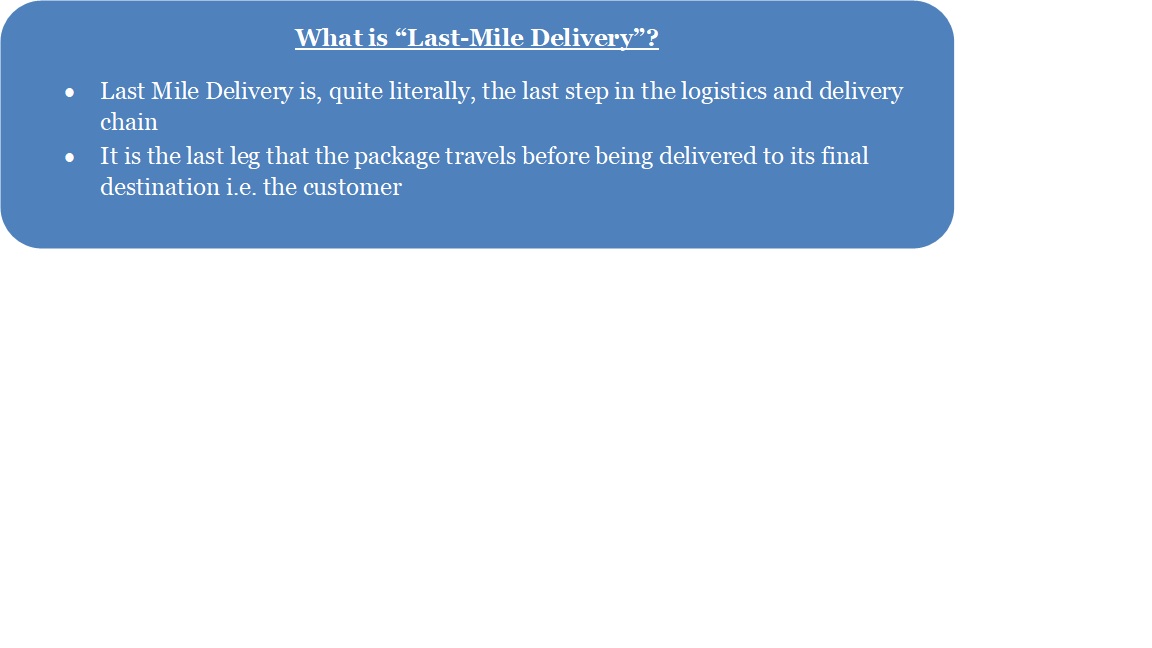
Logistics, distribution, and the challenge of “Last Mile Delivery”
The importance of logistics and distribution of a delivery network, and especially that of the “Last-Mile Delivery” i.e. the last leg of a supply chain during which a package is delivered to the client’s location, has increasingly become a critical element in achieving customer satisfaction and building customer loyalty.
Rapidly evolving customer demands with regards to parcel fulfillment experiences have changed (even forced!) the way companies now tackle such demands. The advent of e-commerce giants has made delivery options like “Same-day delivery”, “2-hour delivery” and “24-hr delivery” – almost unimaginable till even a few years ago! – now a standard expectation! Organizations across the spectrum, including restaurants, retailers, logistics providers, grocers, etc., have been compelled to reimagine how they manage their Last-Mile Delivery.
The Last-Mile Delivery constitutes the most expensive and operationally challenging part of a supply chain. It needs to be relentlessly focused on flexibility, accuracy, speed, and ultimately, timely delivery. Unless this is achieved, a company will fail to achieve customer satisfaction or create brand loyalty. Meeting these rising expectations is not at all an easy task but is unavoidable if firms want to maintain long-term growth and profitability.
What is the “Last-Mile Delivery” process?
Last Mile Delivery, as the name suggests, is the process that Logistics and Distribution companies put in place to successfully manage the logistics of the last mile of delivering their parcels to their customers in the most efficient and cost-effective manner possible.
This includes the use of modern automated systems, software, vehicular fleets, employees, physical warehouses, and fulfillment centers (etc.). Quite obviously, the objective of this complex logistical setup is to enable organizations to ensure the best service and convenience for their customers, especially since the Last-Mile Delivery is the end step of the delivery process and culminates with the successful delivery of the parcel.
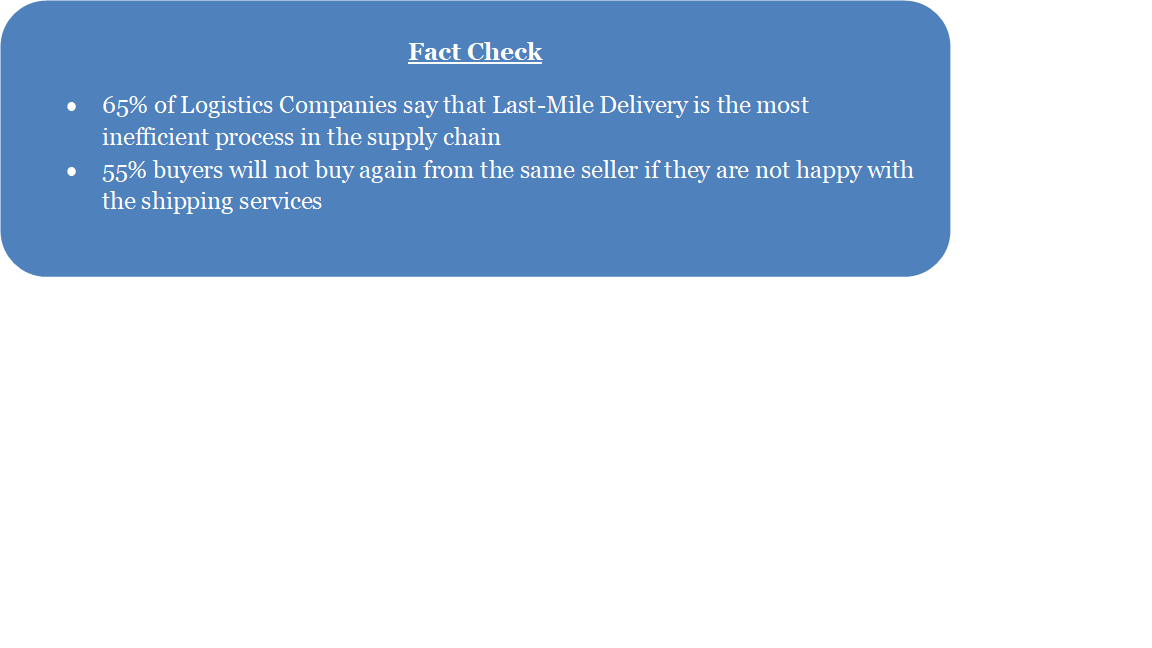
What are the top challenges of the Last-Mile Delivery process?
Some of the challenges include:
- Need for transparency and visibility: Logistics and distribution processes are complex operations with several moving parts and stakeholders. Therefore, it is imperative for Fleet Managers to retain visibility throughout the process right from the point that an order is placed till the point that it is delivered. Included within this loop are critical points such as inventory levels, ongoing open orders across all customer-types (e.g. e-commerce sites), internal processes, drivers and vehicular fleets in operation, final-mile details (etc.). This real-time data and information provides Fleet Managers with real-time visibility to analyze and optimize operations, which in turn, provide the convenience, flexibility and speed that customers expect.
Managing multiple fleets: Organizations that deploy extensive vehicular fleets to manage their daily delivery schedules must ensure they maintain a holistic view of every step of this complex and challenging process. Only then will they be able to maintain an efficient and cost-effective level of service for their clients.
The need for efficient management becomes amplified in managing the Last-Mile Delivery process since this is often the most complex and logistically challenging. In addition to managing the type of vehicle required, one has to balance out numerous variables such as customer demands, fluctuating external conditions like traffic and weather, internal resources (driver availability, nature of goods, etc.).
Managing revenue and costs: While Customer Satisfaction is obviously the ultimate goal of every business, Logistics and Distribution companies cannot lose sight of the fact that not only does this need to be achieved at a price that is feasible for the customer but importantly, at a price that ensures a healthy ROI for the Logistics and Distribution company itself!
A good way of achieving this balance is to operate at an optimal level of scale so that the range of services (e.g. 24-hr delivery, 3-day delivery, etc.) offered to customers is broad-based enough to service a suitable number of customers while enabling the company to suitably balancing the cost of operations.
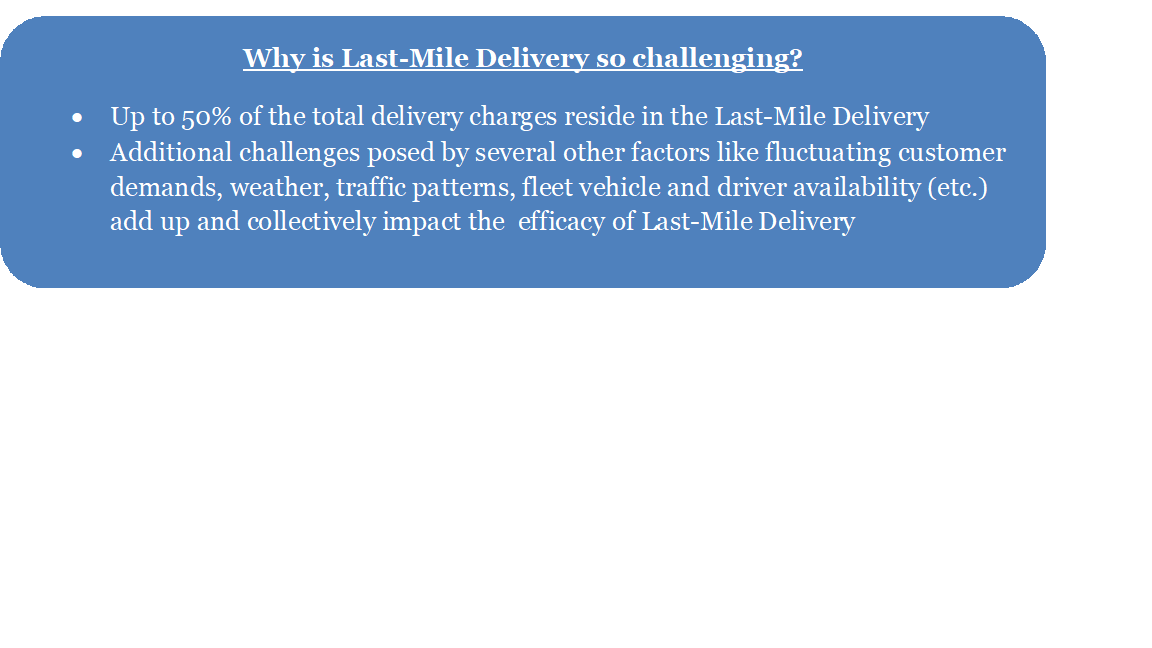
4 steps to optimize Last-Mile Delivery process:
1. Use modern automated systems: it would be impossible to manage the complex, global distribution eco-systems of today’s world without the sufficient use of automation. Therefore, using a fully automated, GPS-enabled last-mile delivery software becomes critical to provide the best delivery experience to your customers. Regardless of the size and type of a business today, it has access to technology that enables it to plan and execute the delivery process efficiently.
2. Use technology that digitizes the entire process: drawing from the point above, Logistics Businesses must select their technology systems judiciously i.e. choose technology that can automate and digitize all steps (and, stakeholders) of the vast distribution eco-system, and in particular, the numerous dynamic elements that constitute the Last-Mile Delivery. Without this, you cannot offer efficient and cost-effective services to your customers while maintaining a healthy bottom line for yourself.
3. Maintain centralized data: Modern logistics and delivery processes are a complex, intricate network that deploys numerous elements including large vehicular fleets, human resources, warehouses, aggregator sites, customers, and suppliers, to name a few. Quite naturally, there are data points being generated at every step of the way from all these individual stakeholders and processes. Unless Logistics and Distribution companies can manage this data holistically, it will lead to inefficiencies and, well, disasters!
The first step to achieve this is by centralizing all the data (and, systems) so that Fleet Managers can access and analyze the entire delivery ecosystem in totality. This is the first step to understanding all the steps leading up to, and within, a Last-Mile Delivery system.
4. Scale gradually: As mentioned above, achieving the correct level of scale for a business is key to maintaining a profitable and successful business. However, just like all the positive elements of a business are amplified at higher levels of scale (e.g. sales, profit, economies-of-scale), so are the pressure points such as high costs, inability to retain control, maintain efficiency, and profitability (etc.). Therefore, firms need to first put in place robust systems and processes (including modern automated systems) before pushing through greater numbers of operations.
Conclusion: It is important to note that customers today often accord more importance to the delivery experience as against the satisfaction from the parcels they receive! Therefore, companies that aspire to market-leadership positions must use exemplary last mile delivery management software to manage their logistics.
How do you simplify your business’s last mile delivery operations
Summary
Fueled by the e-commerce industry, as well as the Covid-19 pandemic in recent times, the number of deliveries has increased exponentially. Along with it, so has the size of the Logistics and Distribution industry.
However, coupled with this increase in demand is also the need for faster and cheaper order fulfillment. This, in turn, has made the management of Last-Mile Delivery logistics an even greater challenge.
The use of modern, automated route optimization software is ideal to simplify a business’ last-mile delivery operations and achieve maximum efficiency and customer satisfaction.
Why is Last-Mile Logistics so troublesome?
Last-Mile delivery is, quite literally, the last leg of the distance along the supply chain that a parcel travels i.e. from the fulfillment center (or, warehouse) to the final delivery address. At this point of the supply chain, the objective of Last-Mile Delivery is to deliver the parcel to its final recipient at the earliest.
Importantly, the Last-Mile is also the most time-consuming and costliest leg of the entire supply chain, often resulting in as much as 50% of the total cost of transportation. Therefore, with every error (or inefficiency, or failure) within the Last-Mile, the negative impacts become greatly amplified.
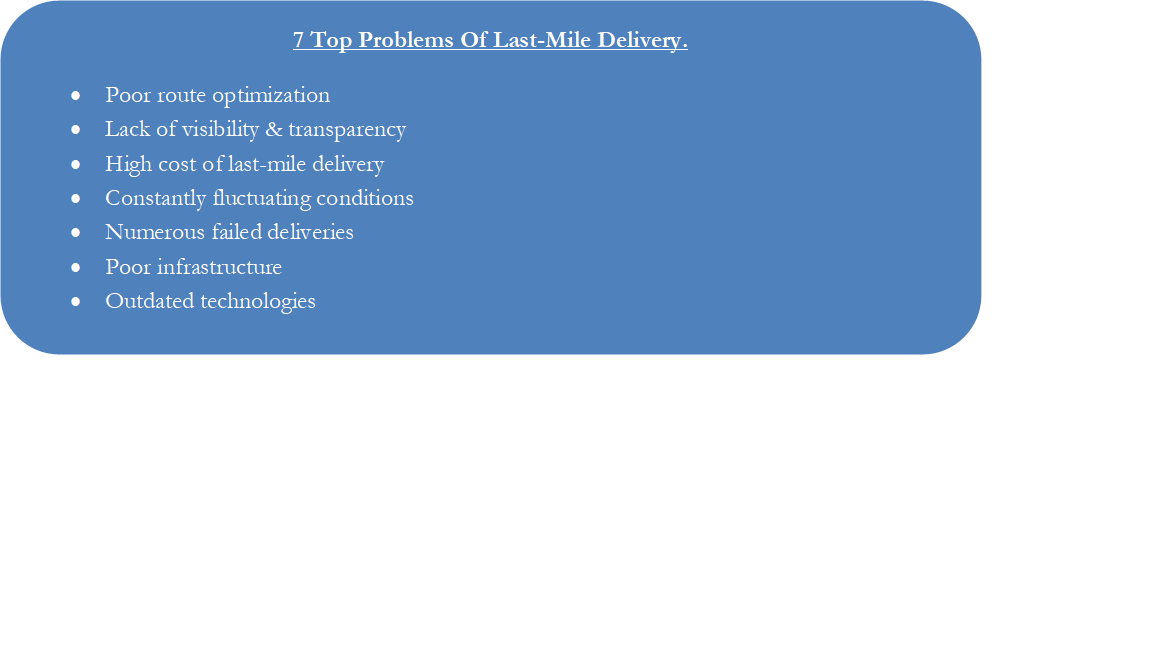
Effects of poor communication on last-mile logistics.
In our faced-paced lives, a majority of the problems arise due to poor communication. This is true in our personal as well as professional lives.
Similarly, poor communication – or, miscommunication – is a leading reason for several problems that arise in last-mile logistics. Given that there are several stakeholders that need to work together seamlessly (under severe time pressure at most times) it isn’t difficult to imagine the chaos that would result should communication lines break down.
Firms nowadays use external vendors like a 3PL and often lease infrastructure such as warehouses or vehicles to optimize their logistics operations without having to make significant CapEx. However, maintaining a seamless operation with such diverse stakeholders that perform so many of the critical tasks not only takes a well-coordinated and planned operation at all times but slight errors can rapidly become dangerously amplified. For example, stakeholders like warehouse managers, sales teams, and procurement managers may have poor visibility of warehouse inventory levels due to poor MIS and ragged internal communication. This leads to problems of OOS and delays in delivery.
Using a modern Logistics and Distribution System that works in real-time while maintaining updated information and data at all times – that can be easily (automatically) accessed by all stakeholders, from ground teams through to Managers – is key to solving the problem.
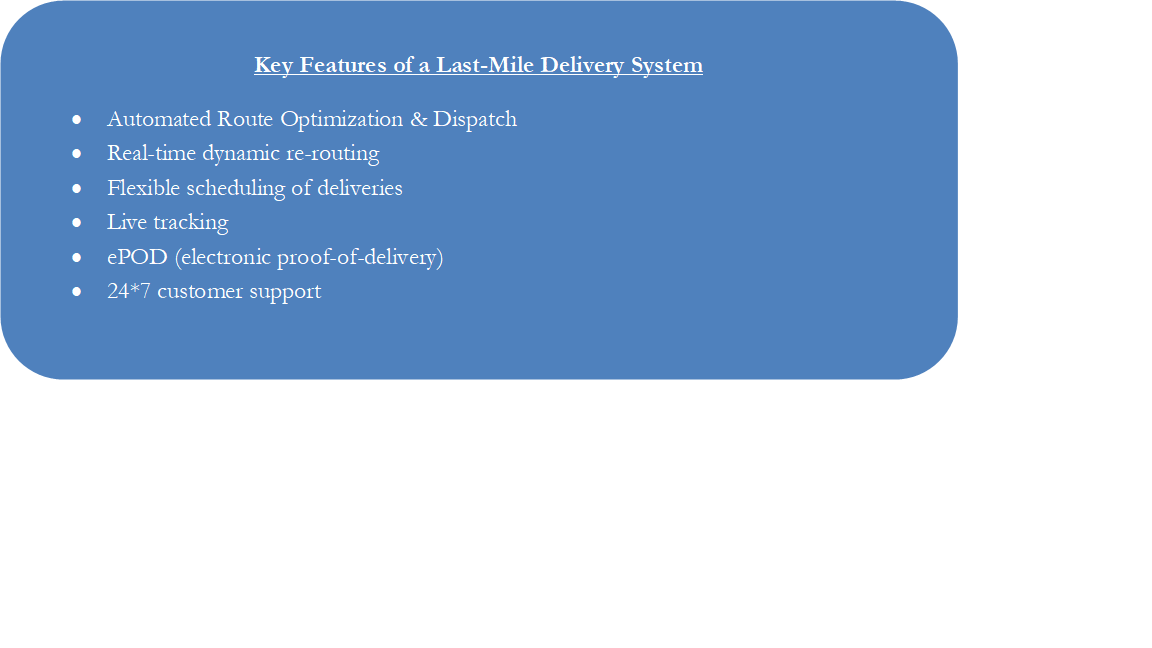
5 elements to achieve efficient last-mile delivery operations
1. Modern technology: The field of Logistics and Distribution has made a quantum leap this millennium with regards to the use of technology. Modern delivery and route optimization software is a vastly improved system that uses complex algorithms fueled by Artificial Intelligence and Machine Learning. This has ensured that all stakeholders and processes of a supply chain are now digitized and brought online. With the ability to crunch vast amounts of data in real-time, such delivery management software makes it possible for Logistics firms to delve into every aspect of their operation, organize daily deliveries and supply chains, draw insight, and monitor the entire process for optimum efficiency.
2. Automatic Route-Optimization: As mentioned above, current technology is a great tool for managing a delivery operation. Perhaps, the best example of this is the modern, GPS-enabled Route Optimization Systems that are now in use.
Such Route Optimization software schedules deliveries automatically, optimizes routes and reduces delivery times, and makes the best use of limited resources (e.g. drivers, vehicles, on-site teams, etc.). It also takes into account numerous (dynamic) variables such as traffic and weather patterns, delivery locations, customer delivery windows, type of cargo, vehicle capacity, inventory levels, warehouse locations (etc.) to come up with the most efficient route. A great feature of such a system is that it can re-route in real-time should any of the original assumptions suddenly change e.g. a breakdown or a traffic jam.
3. Real-Time customer communication: The advent of e-commerce giants like Amazon with their formerly unbelievable delivery times – Same-Day delivery, 24-hr delivery! – has changed expectations of the modern consumer. He now demands flexible delivery windows, options of drop-off and pickup, and to be kept in the loop at all times about the progress of his delivery.
Without it, today’s customers will be left dissatisfied and a firm will not be able to build customer loyalty, which is the final metric in building a sustainable, long-term business.
4. Live delivery-tracking system: In times past, problems of failed deliveries, poor route optimization, missing proof of parcels delivered, and limited modes of electronic payment were not only troublesome but also resulted in poor customer experience. Using an automated system that tracks delivery progress in real-time effectively solves all the issues mentioned.
By using modern live delivery-tracking software, firms and customers can now monitor the status of the parcel as it moves toward its final location. These updates can then be shared with all stakeholders in real-time, thus creating a robust and efficient system.
5. Elaborate warehouse network: A well-distributed and extensively located chain of warehouses and fulfillment centers is critical for managing the last mile. Depending on the location (urban, rural) and the factors that influence it (distances between two points, population density, number of stops along a route, etc.), a well-distributed chain of warehouses is most important. A higher presence of warehouses in areas where most of the orders (deliveries) also allows firms to offer the “pick-up” and “drop-off” facility to clients.
Ideally, the fulfillment center must be as close to the final point of delivery as possible. This helps in minimizing the cost of operations (fuel, operations, delivery teams) and shortening delivery times for greater efficiency.
Conclusion: Using a last mile delivery management software that effectively covers the entire gamut of operations of Logistics and Distribution and brings all stakeholders and processes online in real-time is the most effective way of simplifying and managing last-mile delivery operations.
How Last Mile Delivery Service Providers are Boosting Customer Retention by Using Technology
Summary
As mentioned in this space earlier, gone are the days when companies could maintain a sustainable competitive advantage over competitors purely on the basis of product functionality. In today’s modern age of frenetic competition, that is not enough by itself.
Now, your overall Customer Experience with your brand/company forms the base of building customer loyalty – and by logical extension, ensures customer retention. Importantly, delivery experience is a critical part of this Customer Experience.
To boost customer retention, last-mile delivery companies must create a great delivery experience i.e. ensure on-time delivery, maintain clear communication lines, provide ETAs accurately, the process returns quickly, and have an ear out for customer feedback. Using modern technology and systems is core to achieving this.
Why is last-mile efficiency so crucial in boosting customer retention?
At its very core existence, a market is a place where customers pay money in return for some “value”. The “value” received could be received via a product or a service.
Naturally, the provider of this value – the selling company – makes products and services to suit the requirements of the market i.e. the customers.
However, the delivery of this value to the customer isn’t complete without the customer actually receiving, or consuming, the product or service. This is where “delivery” comes into the game.
Optimizing last-mile delivery to ensure customer retention: The modern customer is a demanding one and is only interested in receiving his parcel on time, and at a place of his choice. They don’t care about the challenges you encounter to achieve this, nor are they concerned with how difficult, or complex, managing last-mile operations actually is! Also, when you add rapid scale-up or run company operations at scale, the challenges that delivery-service providers encounter increase manifold.
However, like all challenges present opportunities, so does last-mile delivery operations. Given that it is a ‘difficult’ task, the firms that get it right are able to generate solid customer loyalty. When customers repeatedly receive their parcels on time, at delivery charges and times that are acceptable, they will be sure to return to those companies again.
Conversely, consumer surveys have repeatedly shown that 2/3rd of today’s customers will look elsewhere once they have had an unhappy delivery experience.
Therefore, manufacturing companies, sellers, E-commerce firms, 3PLs, supply-chain players (etc.) must ensure optimized logistics and delivery operations so that they are able to keep their customers satisfied, as mentioned above.
While delivery companies must constantly experiment with the plethora of (ever-evolving) technologies now available, including driverless cars, drones, robots (etc.), it is also important to stay rooted in the present i.e. to make sure you are servicing your customers by focusing on the core elements of running a solid last-mile delivery operation.
How can last-mile service providers use technology to boost customer retention?
By using technology, last-mile delivery firms can provide customers with what they want. Some leading points include:
1. Providing visibility, accountability, and control to customers: Unless delivery companies and retailers meet customer expectations, they will move to other available options. As mentioned earlier, this has become particularly true for the delivery experience due to the new-age practice of expedited shipping! Additionally, the demand for speedy delivery keeps rising, with companies falling over themselves to be “better, faster, cheaper” than each other.
Spurred by the pandemic, several businesses adopted the Ecommerce way in 2020, in addition to the already burgeoning online world of commerce. However, deliveries still fall short of customer expectations. Recent consumer surveys have revealed high numbers of dissatisfaction with regard to lost, stolen, or damaged packages, as well as delayed deliveries.
In addition to the above, customers display little, or no, tolerance for unreliable updates about shipping status and poor communication lines. Therefore, last-mile companies must prioritize transparency maintained while the packages are in transit.
Order details like accurate delivery times and dates, ETAs, tracking codes, and real-time notifications are par expectations for consumers these days.
“Control” over his delivery options is something that the customer also wants. He wants enough options (delivery methods, prices, payment) to choose from. Offering limited options will likely dissatisfy – even irk! – the modern customer!
However, by offering ample options to suit various need segments and provide customers with control, a company can actually achieve the opposite i.e. customer satisfaction.
Order returns and replacements are a way of the home-delivery model and will never completely go away. However, what consumers expect is that last-mile service providers accept responsibility for mistakes that occur and work responsibly to correct them. Therefore, reverse logistics is an extremely important aspect of maintaining happy customers, which in turn, will ensure customer retention.
Once delivery companies have met – preferably, exceeded – their basic customer expectations with regards to transparency, accountability, and control, they can look toward raising the bar on the overall shopping experience i.e. achieve customer delight, through the use of modern technology.
2. After achieving basic Customer Satisfaction, start aiming for Customer Delight with the use of modern tech: Once retailers, 3PLs, and the delivery service companies have established a solid framework to consistently achieve minimum (basic) levels of operational efficiency required in their last-mile logistics, the next task is to raise the bar. Expressed differently, you now aim to “personalize” the entire shopping-delivery experience for the customer.
Using mobile-scanning technology improves the quality of data and its origins, thereby creating a data trail. This not only provides accountability for Logistics Managers that manage such data but also enables them to give their customers live updates and tracking info.
The last-mile experience is further enhanced by using technologies such as GPS tracking of their parcels while in transit (therefore, any last-minute changes of delivery windows or delivery locations can be made), providing pick-up options like centralized lockers (versus home delivery). This is a great way to “personalize” the entire delivery experience.
Emerging technologies like delivery drones and robots, driverless cars (etc.) are also being tested with success. For example, using delivery drones to deliver small, lightweight items like medicines is showing encouraging results. This is particularly well received by the younger generation of customers.
Lastly, satisfied and confident customers are those that will return.
Last mile delivery is the last stage of the delivery process. It is the most challenging, complex, and expensive. Once your customers develop confidence in your delivery (and, overall shopping) services, they will be highly inclined to return. Effectively put, it is where you win –or, lose – and retain customers.
Conclusion: As is evident, last-mile delivery service providers must deploy a holistic and comprehensive approach – with the help of modern software like last mile delivery software – to achieve customer satisfaction. Meeting customer expectations is the only way to ensure customer retention and repeat business.
How Can Delivery Management Software Streamline Ecommerce Delivery Operations?
Summary
Modern Ecommerce logistics is a complex and challenging task – often, the wrong products are delivered, deliveries are delayed or rejected, and irate customers fume that they will never order from you again, naturally causing real reason for alarm!
Deploying the use of modern – and, most able! – delivery management software ensures that such problems are not only accounted for at the planning stage but also suitably addressed should they arise in day-to-day operations.
What is delivery management software?
A software, or, system – that streamlines the delivery operations from start to end. It brings online all stakeholders that are involved with the delivery process, starting from supply-chain participants through to delivery teams, drivers, and the end consumer.
Delivery Teams are able to automate dispatch operations, optimize delivery routes, make alterations to pre-determined schedules based on changes (like traffic and weather), keep customers updated in real-time, and also organize reverse logistics on the go.
What are the benefits of Delivery Management Software?
Let’s look at some leading benefits:
- Increased delivery-efficiency: Logistics Managers can ensure a better and more efficient delivery experience since they can now track delivery operations, mode of delivery, receive and provide live statuses (etc.)
- Optimum use of resources: Since all elements that go into the running of a successful delivery operation is managed in great detail via an automated system that balances out all available resources against the objectives that need to be achieved, a delivery management system ensures that it deploys its resources for maximum result
- Seamless operations: The software is compatible across the MIS and other key systems that are used by the various stakeholders that work in close coordination. As a result, it ensures transparency and seamlessness across the entire supply chain
CASE STUDY
Situation: Messrs. Beauty Online is a new and upcoming D2C brand in the Beauty and Wellness Segment. Like a lot of modern-day companies that have the opportunity to start by using online channels, so did they.
Problem: Beauty Online seems to be encountering what is commonly referred to as the problem of plenty! They have experienced rapid growth over the past few years and have also received robust rounds of funding from their investors.
As is typical of D2C brands that experience good growth, they have also expanded to using an omnichannel retail strategy i.e. in addition to using popular E-commerce platforms as well as their own online store, they are now in offline stores as well – as a result, this has meant an increasingly complex and demanding delivery operation.
Additionally, a widening base of customers has meant that they need pricing options, suitable delivery windows, and of course, the (inevitable) corresponding increase in order returns and reverse logistics. In recent times, Beauty Online’s leadership has realized that they are struggling to stay on top of such an increasingly demanding logistics operation, and as a result, are regularly coming up short in meeting customer expectations.
While they are just about staying ahead of the curve through a combination of fire-fighting and impromptu decision-making, they have also realized that sooner or later, it will start affecting customer confidence and therefore, brand equity and repeat orders.
Solution: That is when company management decided to stop managing its own order-fulfillment and brought in a reputed 3PL.
Not only did the 3PL bring with it ample expertise in logistics management, but they also had important inputs on matters of packaging, usage of smaller warehouses (based closer to urban centers) to cut delivery times, and a checklist of best practices to streamline Beauty Online’s overall eCommerce delivery management.
End-to-end delivery operations management: By deploying the 3PL’s advanced tech-led solutions such as modern delivery management software, route optimization techniques, and advanced data analytics to study past consumer behavior to predict future patterns of demand, ABC and the 3PL were able to:
- Capture and record order-dispatch details in real-time
- This data – and insight generated thereof – was made accessible to all supply-chain stakeholders as well as customers via cloud servers, data-centers, data systems, and real-time notifications
Result:
- By streamlining the delivery operations, Beauty Online was able to achieve 100% transparency in their (increasingly) complex logistics operations.
- As a result, all supply-chain stakeholders (from raw material suppliers, converters, distributors, and last-mile teams through to the end customer) were updated in real-time about the delivery operations and their parcel movement
- Any changes to the original schedule (e.g. due to traffic or weather), as well as order returns were communicated and handled with efficiency and promptness
- Beauty Online is extremely happy with the results that their collaboration with a 3PL has brought them. Aided by modern tech-led systems of their 3PL, Beauty Online continues to break new ground in terms of improving quarter-over-quarter performance
How does delivery management software streamline an Ecommerce delivery operation?
Modern, automated delivery management software takes a holistic look at the entire gamut of Ecommerce logistics operations, and uses automation to cover all roles and areas, thereby streamlining the entire process.
1) Tracking key KPIs: enables Logistics Managers to come up with optimum routes and delivery schedules.
- Timely delivery rates
- Fleet driver and vehicle performance
- Customer feedback
- Reverse-logistics
2) Automated delivery scheduling: is enhanced by using key performance parameters such as:
- Effectiveness of routes available
- Tracking vehicle locations in real-time
- Operational efficiency e.g. fuel consumption
3) Real-time tracking: Enables logistics managers to maintain 100% transparency and visibility. This helps in gaining a holistic view of all ground-level operations from start to finish, something which was not possible before the days of automated dispatch software
4) Connecting via the Mobile App: Today’s delivery software is deployed via the driver’s mobile phones and therefore allows far greater efficiency, communication, and levels of connectedness that was otherwise unthinkable!
It is now easy to synchronize routes, delivery schedules, customer info, and delivery completion details (e.g. order status, ePOD) between delivery teams and central teams via cloud-tech and mobile apps.
5) Improved Customer Experience: Ecommerce customers have several options to choose from. Therefore, keeping them in the loop about their parcel movements, ETA, delays (if any), and driver delivery details help keep them satisfied. This is the first step toward achieving Customer Satisfaction, which in turn, achieves customer retention and repeat business.
Conclusion: As is evident, delivery management software, also called last mile delivery software, is a robust tool that uses a vast array of modern and automated tech-led tools to streamline the entire process of E-commerce delivery operations to achieve efficiency, profitability, and optimal use of available resources.
How Delivery Management Software Helps You To Manage Multiple Delivery Channels
1) Why is it difficult to manage multiple delivery channels?
The era of hyperactivity is upon us. Our lives, both personal and professional, are impacted by the seemingly unending sequence of activity, communication, tasks, and competition! FOMO (Fear Of Missing Out) fuels a lot of hyperactivity in our personal lives whereas relentless competition ensures it in our professional ones.
Out there in the marketplace, we are faced with the constant challenge of winning and retaining customers. There too, the customer has evolved and is wooed by your competitors. Plus, weaned as he is on the “Amazon-ization” of delivery (Same-Day, 24-hr) you have to necessarily rely on multiple delivery channels to keep him satisfied.
To do so isn’t an easy task at all. Various supply chains, numerous stakeholders, payment terms and conditions, tax regimes, workers, warehouses, logistics, fleet vehicles, and drivers…well, the list is an unending one!
Therefore, your best bet for managing multiple delivery channels is to use modern technology. Enter, today’s robust Delivery Management Software.
This blog focuses on how Delivery Management Software helps streamline your business processes, organize your operations, and achieve customer satisfaction. Ultimately, that creates a sustainable and profitable business model.
2) What is Delivery Management Software?
Delivery Management Software (DMS) is a software system for firms to manage their delivery operations through a unified online platform.
It is a comprehensive solution that enables organizations to manage all aspects of delivery, including dispatch, tracking, confirmation of delivery, and customer management. Any firm that seeks to manage its delivery operations could deploy DMS, regardless of size, industry, or complexity of operations.
3) How can companies manage multiple delivery channels with DMS?
A modern DMS is equipped with several features that help firms to efficiently manage numerous delivery channels. Let’s look at some highlights:
i) Efficient dispatching: DMS lets you dispatch deliveries efficiently. Assigning deliveries based on drivers, vehicle availability and capacity, end-destination, routes available (etc.) are some variables that the software balances out in coming up with an efficient dispatch system. This helps in reducing fuel costs and delivery times.
ii) Real-time tracking: With DMS, you can track all your deliveries in real-time from the moment it leaves your warehouses till it is delivered at their end destination. Since you can monitor your delivery vehicles and drivers in real-time, you can also spot any delays/issues and take prompt actions to correct them.
iii) Delivery confirmation: DMS can capture delivery confirmation immediately through modern digital methods including photos, barcode scanning, and e-signatures. This data is uploaded on cloud servers immediately wherefrom they can be accessed. Both, seller and buyer, are rest assured that the delivery has been completed and the formalities completed in due accordance.
iv) Data analytics: A powerful feature of modern DMS is its robust data analytics capability, further empowered by the use of AI and ML. This helps in analyzing key performance metrics such as delivery times, cost-per-delivery, company productivity (etc.). You can study such data at an individual level and even club them into groups e.g. by day-parts, by route, by week
v) Customer communication: An important part of customer service in today’s times is two-way communication with them in real time.
With DMS, you can send information about delivery progress (e.g. delivery confirmation, tracking information) via automated notifications, SMS, and emails as well as receive queries from customers. This is key to achieving customer satisfaction.
4) Case Study: Managing Multiple Delivery Channels Delivery With Management Software
Situation: Hybrid Inc. is a rapidly growing retail firm. They are present both, offline and online. It uses multiple delivery channels such as local delivery, in-store pickup, and 3PLs. But, as their topline grew rapidly, it soon became evident that their delivery operations were increasingly inefficient and they were struggling to manage these multiple channels. As a result, they were creating unhappy customers and struggling with a drain on margins. Common problems included:
- Delayed/ incorrect deliveries: This happened with alarming regularity. Customers were left disappointed and dissatisfied. The reverse-order logistics and fulfillment were also way below par
- Poor routing: Manual planning of delivery routes resulted in inefficiency (e.g. high fuel costs, inefficient use of resources)
- Poor visibility: Current processes didn’t provide any visibility into the delivery process to the company or its customers
- Lack of automatic updates: With their manual system, there weren’t any automatic notifications in real time. This resulted in inaccuracies and delays
- Poor communication: The communication between the delivery team and the customers was limited, leading to customer dissatisfaction
Solution: Therefore, the company management decided to install a DMS to improve their overall delivery performance and also to streamline all its touch-points with the other parts of their operations.
- Optimized routing: Perhaps, the greatest benefit of the software is how it automates routing. It optimizes delivery routes, shortens delivery times, maximizes drops-per-route, lowers fuel costs, and ensures optimal usage of resources (e.g. fleet vehicles, drivers) to achieve a minimal cost of operation while improving operating performance
- Improves visibility: The DMS provides visibility in real-time for customers and enables delivery tracking. This helps clients in monitoring and improving their performance
- Real-time updates & communication: With real-time delivery tracking, companies can provide notifications and updates. No longer do they need to rely on manual updates that are riddled with errors and delays. Such improved communication is critical for taking care of customer needs, especially during delays or changes to the delivery-windows
Results: Upon successful implementation of the DMS, the following improvements were observed:
- Improved routing: Optimized routing resulted in reduced fuel costs and improved routing-efficiency
- Improved visibility: Enabled Hybrid Inc. to track its deliveries and draw insight for better decision-making
- Improved delivery operations: Lower delivery times, fewer errors, better usage of fleet drivers and vehicles. This also lowered operating-cost
- Improved communication: Real-time communication between the company and customers ensured quality and speed of communication
- Improved customer satisfaction: As always, the final metric of a company’s performance. Hyrbid Inc. was delighted to see how their customer satisfaction rates were much better than those earlier.
Conclusion: As is evident, Delivery Management Software is an integral tool for companies to manage multiple delivery channels effectively. It streamlines business operations, improves efficiency, and ultimately, achieves customer satisfaction.
